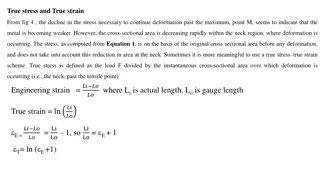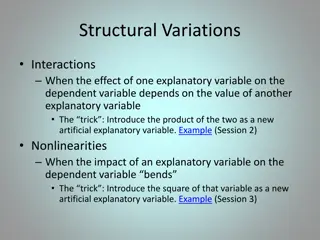Understanding Explanatory Cross-Sectional Designs in Research
Explore the world of cross-sectional designs in research, focusing on the explanatory type that delves into relationships among variables within populations. Learn about the distinctive features, types of designs, and research objectives associated with this methodology.
Download Presentation

Please find below an Image/Link to download the presentation.
The content on the website is provided AS IS for your information and personal use only. It may not be sold, licensed, or shared on other websites without obtaining consent from the author. Download presentation by click this link. If you encounter any issues during the download, it is possible that the publisher has removed the file from their server.
E N D
Presentation Transcript
Research Objective Study relationships among variables for existing groups Show direct cause & effect Explain outcomes after the fact
Type of Design Cross-Sectional Longitudinal True Experiment Quasi-Experiment Explanatory Case Study Exploratory Case Study
Descriptive Cross-Sectionals Many cross-sectionals are purely descriptive of the characteristics of a population, often of a single population with no comparison group Do not use one of these in this class; it is not acceptable I will not address these designs further in this slide show.
Explanatory Cross-Sectionals Explanatory cross-sectionals identify the relationships among several (sometimes many) variables within one or more populations Most use two or more comparison groups, although some test how well two or more theories explain the relationships within a single population There are generally numerous predictor variables based on the constructs in one or more theories There may also be more than one outcome variable
Distinctive Features Groups or populations are usually defined based on the outcome variable the variable of interest in the study, but may also be based on one or more independent or predictor variables. The comparison groups are NOT created by an intervention or treatment They allow us to assess the strength of the relationships among variables through qualitative or quantitative analysis
Did you select one or more characteristics to define the population(s) of interest? Yes No Not an explanatory cross-sectional Did you select (preferably randomly) a representative sample of each population of interest based on the characteristics used to define the population(s)? Yes No Not an explanatory cross-sectional Did you collect information from each sample based on the predictor and outcome variables of interest? Yes No Not an explanatory cross-sectional Explanatory Cross-sectional Design
Simple Cross-Sectional with Two or More Comparison Populations 2 or more existing comparison populations A single measurement at one point in time In the diagram P=population, RS=representative sample, M=measurement of variables Define P1 Define P2 Define P3 RS from P1 RS from P2 RS from P3 M1 M1 M1
Example of Simple Design Research question: How does time between marriage and birth of first child affect marital satisfaction of women?
Population & Comparison Groups Required Characteristics: Married women (not divorced or separated); women who have been married only once; and women who have been married less than 10 years These are screening criteria and you use them to try to control other factors that could affect marital satisfaction that are not of interest (previous marriages) Comparison populations/groups: P1 consists of women who were married less than 2 years when the first child was born; P2 is women who were married 2 or more years when the first child was born
Hypotheses Primary hypothesis: Marital satisfaction will be lower for women married less than two years when the first child was born (one-tailed). Other theory-based hypotheses: There would probably be several of these, all based on constructs in the theory of this form There will be a positive correlation between . Non-theory-based hypotheses: These deal with various characteristics that could affect the relationship between time to birth of first child and marital satisfaction, such as size of the woman s family, educational level, profession, financial resources
Sample & Measure Select a statistically representative random sample of each population (or as close as you can get) Measure for all independent or predictor and dependent or outcome variables (theory-based and other)
Analysis All analyses can be either statistical or qualitative Test the primary hypothesis first. If there is NO difference between groups for the outcome, you can treat the population as a single population and single sample. However, I recommend continuing testing as two or more populations. Then test the other hypotheses. Most researchers want to create some sort of statistical or qualitative model of the relationships for the comparison groups.
Cross-Sectional with Repeated Measures in Time Most cross-sectional designs have no time component, but a time component can be added with repeated measures In cross-sectionals, sampling occurs before each measurement unlike longitudinal designs the participants at each measurement are different people, a different sample, drawn from the population(s) Define P1 Define P2 Define P3 RS1 from P1 M1 RS2 from P1 RS1 from P2 M1 RS2 from P2 RS1 from P3 M1 RS2 from P3 M2 M2 M2
Multiple Cohort Designs Multiple cohorts sampled over time allow you to determine how the relationships between variables changes over time, the assumption being that such changes are due to broad societal processes The cohorts are simply different age groups in many cases E.g., Financial security over time for people born in 1960-69, 70-79, etc. In these cases, the cohorts are essentially the theoretical populations. In this example, we might assume that the financial turbulence since 2000 has affected these cohorts differently. P1 (1980-89) P2 (1990-99) P3 (2000-09) P4 (2010-19) RS from P1 RS from P2 RS from P3 RS from P4 M1 M1 M1 M1
Multiple Measures with Cohorts In other cases, researchers combine multiple cohorts with multiple measures over time. In our example this would reveal how financial security changes over time for people born in the different decades. We might hypothesize that financial security will decline for all populations over time and that the decline will be greater for P1 than P2, P2 than P3, etc. Again, remember that we draw a new sample for each measurement. P1 P2 P3 P4 RS1 from P1 RS1 from P2 RS1 from P3 RS1 from P4 M1 M1 M1 M1 RS2 from P1 RS2 from P2 RS2 from P3 RS2 from P4 M2 M2 M2 M2
Cross-Sectional Before & After Some Event These are almost always retrospective designs and are subject to the limitations of retrospective designs, which include things like people s ability to remember past feelings and actions, events coloring or changing how we perceived things prior to the event. More commonly, people try to treat these as some form of quasi-experiment. They are NOT a quasi-experiment in most cases. They are only experiments IF some intervention that changed the individuals involved occurred like the 9/11 contamination in NYC.
Example To what degree did Hilary Clinton s gender (not her politics, etc.) affect voting behavior in the 2016 presidential election? The two populations would be those that voted for her and those that did not. We could use several of the gender theories for this study and I will not discuss the theories here. Assume we did measurement 1 right after the election. We could add a second measurement now, which would improve our study because we could see if the importance of gender in the voting decision has remained stable or changed. This is not an experiment because nothing was done to people they just acted on their personal views and experiences. No prod. P1 (yes) RS from P1 P2 (no) RS from P2 M1 M1 RS2 from P1 M2 RS2 from P2 M2
Sampling Both statistical and theoretical generalization depend largely on adequacy of the sample The researcher usually (not always) needs a statistically representative random sample with regard to the characteristics of the population that we think may affect the variables (independent and dependent) under study or as close as you can get.
Describing the Sample Describe the sample fully in the results section of your study the reader must have good information to decide if your sample is adequate or not. This is not really data analysis, just a demographic description of the sample that is used (often incorrectly) to demonstrate that the sample is adequate. In this case, demographics are important traits (based on theory and prior research findings about voting behavior and gender). Therefore, the match between these traits and the samples are important.
What to Include The norm is to include demographic data about the sample to show whether it is or is not broadly representative of the population(s) of interest with regard to these characteristics. But focus on the characteristics of the sample that may affect the outcomes of the study that s what really matters in terms of the adequacy of the sample. You can also use various procedures to enhance sampling. One is sampling intensity.
Take Home Points Cross-sectionals are not a substitute for experiments or any other design. They fail to meet the requirements required to demonstrate direct cause and effect. If well designed, they may provide tentative indications of causality. They allow the researcher to explore relationships among several theoretically related variables, which can add significantly to explanatory power.
Cross-sectionals depend on the use of comparison groups to indicate causality. All one group designs are basically descriptive in nature because there is no way to know whether absence of the condition of interest produces the same outcome as presence of the condition without a comparison group. They depend heavily on a representative, independent sample of each comparison population, preferably a statistically representative sample. However, they are over-utilized in much social research, probably because they are relatively quick and inexpensive especially the single population descriptive study.























